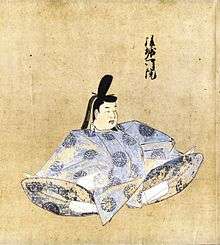Emperor Go-Horikawa
| Go-Horikawa | |
|---|---|
 | |
| Emperor of Japan | |
| Reign | 1221–1232 CE |
| Predecessor | Chūkyō |
| Successor | Shijō |
| Born | March 22, 1212 CE |
| Died | August 31, 1234 (aged 22) |
| Burial | Kannon-ji no Misasagi (Kyoto) |
| Spouse |
Fujiwara no Ariko Fujiwara no Chōshi Fujiwara no Shunshi |
| Issue |
Emperor Shijō |
| House | Yamato |
| Father | Prince Morisada |
Emperor Go-Horikawa (後堀河天皇 Go-Horikawa-tennō) (March 22, 1212 CE – August 31, 1234 CE) was the 86th emperor of Japan, according to the traditional order of succession. His reign spanned the years from 1221 CE through 1232 CE.[1]
This 13th-century sovereign was named after the 10th-century Emperor Horikawa and go- (後), translates literally as "later"; and thus, he is sometimes called the "Later Emperor Horikawa". The Japanese word go has also been translated to mean the "second one;" and in some older sources, this emperor may be identified as "Horikawa, the second," or as "Horikawa II."
Genealogy
Before his ascension to the Chrysanthemum Throne, his personal name (his imina)[2] was Yutahito-shinnō (茂仁親王),[3] also known as Motsihito-shinnō.[4] The third son of Imperial Prince Morisada (守貞親王) (Go-Takakura-in, 後高倉院), the second son of Emperor Takakura.
- Empress (Jingū): Sanjō (Fujiwara) Ariuko (三条(藤原)有子) later Ankimon’in (安喜門院), Sanjo Kinfusa’s daughter
- Empress (Chūgū): Konoe (Fujiwara) Nagako (近衛(藤原)長子)[5]Later Takatsukasa’in (鷹司院), Konoe Iezane’s daughter.
- Empress (Chūgū): Kujō (Fujiwara) Sonshi (九条(藤原)竴子)[6]Later Sōhekimon’in (藻璧門院), Kujo Michiie’s daughter
- First son: Imperial Prince Mitsuhito (秀仁親王) (Emperor Shijō)
- Fourth daughter: Imperial Princess ?? (皞子内親王; 1232-1237)
- Second Son (1233)
- Lady-in-waiting: Jimyōin (Fujiwara) no Motoko, Daughter of Jimyōin (Fujiwara) Ieyuki (持明院(藤原)家行)[7]
- First daughter: Imperial Princess Kishi (暉子内親王; 1228-1300)
- Second daughter: Imperial Princess Taishi (体子内親王; 1231-1302) married Emperor Go-Saga
- Lady-in-waiting: Dainagon-no-Tsubone (大納言局), Daughter of Fujiwara Kaneyoshi (藤原兼良)
- Third daughter: Imperial Princess Akiko (昱子内親王; 1231-1246)
Events of Go-Horikawa's life
In 1221 CE, because of the Jōkyū Incident, an unsuccessful attempt by Emperor Go-Toba to seize real power, the Kamakura shogunate completely excluded those of the imperial family descended from Emperor Go-Toba from the Chrysanthemum throne, thus forcing Emperor Chūkyō to abdicate. After the Genpei War, he, as the grandson of the late Emperor Takakura, who was also a nephew of the then-exiled Retired Emperor Go-Toba, and Chūkyō's first cousin, was enthroned as Go-Horikawa. He ruled from July 29, 1221 CE to October 26 (?), 1232 CE.
- 1221 CE (Jōkyū 3, 9th day of the 7th month): In the 1st year of what is now considered to have been Chūkyō-tennō 's reign (仲恭天皇一年), he abruptly abdicated without designating an heir; and contemporary scholars then construed that the succession (‘‘senso’’)[8] was received by a grandson of former Emperor Go-Toba.[9]
- 1221 CE (Jōkyū 3, 1st day of the 12th month): Emperor Go-Horikawa acceded to the throne (‘‘sokui’’).[10]
As Go-Horikawa was only ten-years-old at this time, his father Imperial Prince Morisada acted as cloistered emperor under the name Go-Takakura-in.[11]
In 1232 CE, he began his own cloistered rule, abdicating to his 1-year-old son, Emperor Shijō. However, he had a weak constitution, and his cloistered rule lasted just under two years before he died.
Emperor Go-Horikawa's Imperial tomb (misasagi) is at Sennyū-ji in the Nochi no Tsukinowa no Higashiyama no misasagi (後月輪東山陵).[12]
Kugyō
Kugyō (公卿) is a collective term for the very few most powerful men attached to the court of the Emperor of Japan in pre-Meiji eras.
In general, this elite group included only three to four men at a time. These were hereditary courtiers whose experience and background would have brought them to the pinnacle of a life's career. During Go-Horikawa's reign, this apex of the Daijō-kan included:
Eras of Go-Horikawa's reign
The years of Go-Horikawa's reign are more specifically identified by more than one era name or nengō.[4]
See also
Notes

- ↑ Titsingh, Isaac. (1834). Annales des empereurs du Japon, pp. 238–241; Brown, Delmer et al. (1979). Gukanshō, pp. 344–345; Varley, H. Paul. (1980). Jinnō Shōtōki. pp. 226–227.
- ↑ Brown, pp. 264; n.b., up until the time of Emperor Jomei, the personal names of the emperors (their iminia) were very long and people did not generally use them. The number of characters in each name diminished after Jomei's reign.
- ↑ Brown, p. 344; Varley, p. 226.
- 1 2 Titsingh, p. 238.
- ↑ Titsingh, p. 240.
- ↑ A History of Japan to 1334, George Sansom, p406
- ↑ The Emergence of Japanese Kingship, p5
- ↑ Varley, p. 44; n.b., a distinct act of senso is unrecognized prior to Emperor Tenji; and all sovereigns except Jitō, Yōzei, Go-Toba, and Fushimi have senso and sokui in the same year until the reign of Emperor Go-Murakami.
- ↑ Brown, p. 344; Titsingh, p. 238.
- ↑ Titsingh, p. 95; Brown, p. 344; Varley, p. 44.
- ↑ Titsingh, p. 238; Brown, pp. 344–345; Varley, p. 226.
- ↑ Sennyū-ji: images of front of Imperial mausoleum enclosure
- 1 2 3 4 Brown, p. 345.
References
- Brown, Delmer M. and Ichirō Ishida, eds. (1979). [ Jien, c. 1220], Gukanshō (The Future and the Past, a translation and study of the Gukanshō, an interpretative history of Japan written in 1219). Berkeley: University of California Press. ISBN 0-520-03460-0
- Ponsonby-Fane, Richard Arthur Brabazon. (1959). The Imperial House of Japan. Kyoto: Ponsonby Memorial Society. OCLC 194887
- Titsingh, Isaac, ed. (1834). [Siyun-sai Rin-siyo/Hayashi Gahō, 1652], Nipon o daï itsi ran; ou, Annales des empereurs du Japon. Paris: Oriental Translation Fund of Great Britain and Ireland.
- Varley, H. Paul , ed. (1980). [ Kitabatake Chikafusa, 1359], Jinnō Shōtōki (A Chronicle of Gods and Sovereigns: Jinnō Shōtōki. New York: Columbia University Press. ISBN 0-231-04940-4
| Regnal titles | ||
|---|---|---|
| Preceded by Emperor Chūkyō |
Emperor of Japan: Go-Horikawa 1221–1232 |
Succeeded by Emperor Shijō |